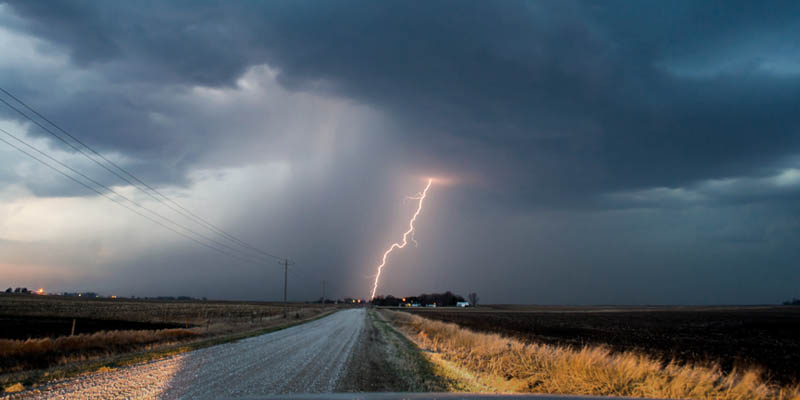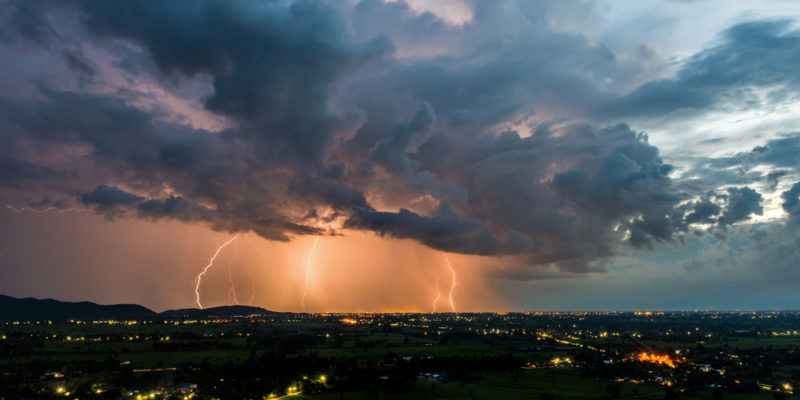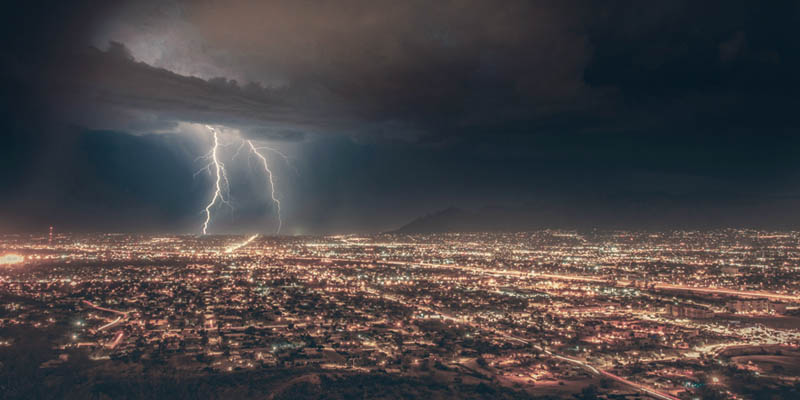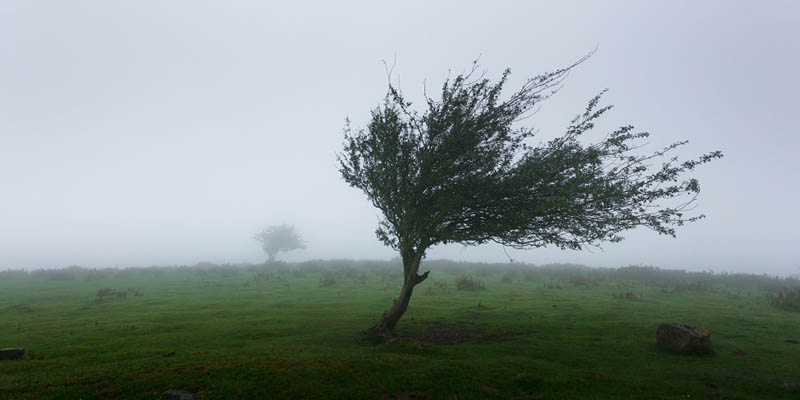We explore thunderstorms, and explain how they are formed. In addition, we discuss their characteristics, effects, and types.

What is a thunderstorm?
A thunderstorm is a meteorological phenomenon characterized by atmospheric instability (manifested by heavy rain, strong winds, and sometimes hail), as well as by the presence of lightning and thunder.
Thunderstorms are formed when a warm, moist air mass meets a cold air mass. This results in the formation of high, dark and very unstable clouds, called "cumulonimbus", which cause thunderstorms.
Thunderstorms typically produce heavy rainfall in a very short period of time, which can cause flooding and property damage.
- See also: Sandstorm
How do thunderstorms form?

Thunderstorms result from the combination of atmospheric factors including heat, moisture, and vertical air movements. These movements lift warm, moist air into the upper atmosphere, where it meets cooler air.
As warm, moist air rises and cools, it condenses and forms clouds. As the clouds continue to grow in size and moisture load, water and ice particles become electrically charged due to friction and collision inside the clouds.
In this way cumulonimbus clouds are formed, which have great vertical development, as they can exceed 33,000 feet (10,000 m) in height, and are characterized by high humidity and electrical activity.
The negative electrical charge accumulates at the bottom of storm clouds, while the positive charge accumulates at the top. As the electrical charge intensifies, a discharge may occur inside the cloud, or between the cloud and the surface, called "lightning".
At the same time, the energy released by lightning heats the surrounding air to very high temperatures, producing a sound known as "thunder".
Types of thunderstorms

According to their nature, thunderstorms can be classified into:
- Single-cell storms. These are isolated storms that form from a single storm cell. They produce lightning, thunder, hail, and heavy rain.
- Multi-cell clusters. They have two or more cells that organize into a larger storm. They cause flooding, brief tornadoes, and produce hail, resulting in significant property damage.
- Squall lines. These are lines of active storms with hurricane-force winds, heavy rainfall, and a common front that can extend for several hundred miles.
- Supercell thunderstorms. These storms are fed by a large energy charge through a circuit of updrafts, and can be particularly destructive because of their hurricane-force winds. They can remain active for many hours and travel great distances.
- Bow echoes. They are so called because they appear in the shape of an arc on radars. They produce very strong winds and rain gusts, and their "arc" can be hundreds of miles long.
- Mesoscale convective systems. These are large-scale thunderstorm clusters that can affect several states and even whole countries. They can last for many hours and produce strong winds, heavy rain, flooding, and hail.
Effects of thunderstorms

The main consequence of a thunderstorm is lightning, which can strike objects and people, causing serious injuries and even death. In addition, lightning can cause fires, and damage electrical and electronic devices.
Strong winds may damage buildings, vehicles, and structures, and can be very dangerous for people who are not sheltered from the storm.
Moreover, heavy rainfall produced by thunderstorms may cause flooding, as they are usually torrential, occurring in a short period of time.
Finally, thunderstorms are sometimes accompanied by hail, which can damage crops, vehicles, and structures.
Stages of a thunderstorm
Thunderstorms have three stages:
- Developing stage. During this stage, warm air rises producing cumulonimbus clouds. The beginning of the storm is characterized by the formation of dark, vertical clouds that grow in height rapidly.
- Mature stage. The vertical growth of the storm reaches its maximum level, and the clouds acquire their typical tower shape. The lower part of the storm is dark gray, while the upper part appears lighter in color due to ice crystals. This is the most likely time for the heaviest precipitation, the strongest winds, and the highest occurrence of lightning and thunder, with possible episodes of hail. If the thunderstorm occurs during the day, dark clouds block out sunlight and the sky turns dark as if it were dusk.
- Dissipating stage. This is the time when the storm loses strength and intensity. Rain becomes lighter, winds lose speed, and lightning and thunder occur less frequently.
How does thunder form?

During a thunderstorm, lightning appears as giant "sparks". When this happens, the air around the lightning heats up and expands at high speed. This expansion produces sound waves, which are the thunders we hear during thunderstorms.
Since the speed of light is greater than the speed of sound, we first see lightning and seconds later we hear the thunder.
What causes lightning?
Lightning occurs due to the accumulation of electrical charges during a storm or similar phenomena, such as volcanic eruptions.
When the accumulated electrical charge is large enough, a sudden discharge occurs in the form of lightning. This discharge can happen inside the storm cloud, between two clouds, or between the cloud and the ground.
Where does lightning usually strike? Lightning from a thunderstorm usually strikes high points close to the storm, such as trees or tall buildings. Additionally, metallic elements, electrical or electronic devices and water also act as attractions for lightning due to their good electrical conductivity.
How far away is a thunderstorm?
There is a method for calculating the distance from a storm, based on the difference between the speed of sound and light.
The difference between the time lightning strikes and the sound of thunder is heard is always perceptible. This happens because light travels at approximately 186,400 miles per second (300,000 km/s) while sound travels at 1,090 feet per second (332 m/s).
Therefore, to determine the distance to a storm in miles, count the number of seconds that pass from the time when the lightning is seen until the thunder is heard, and then divide that number by 5. For example, if 15 seconds elapse between the lightning and the thunder, it means that the storm is approximately 3 miles (5 km) away.
Why are thunderstorms dangerous?

The greatest danger of a thunderstorm is the presence of lightning. Lightning bolts are particularly dangerous because they can very rapidly release a great amount of energy, which can reach several hundred megawatts.
Such electrical power is capable of causing electromagnetic damage to digital or electronic equipment and seriously injuring a person or animal through direct or indirect contact.
Thunderstorm safety tips

Some of the safety measures that can be taken in the event of a thunderstorm are:
- Seek shelter from the wind and rain.
- Avoid open spaces.
- Avoid standing near tall objects like trees, light poles, or any metal object that might attract lightning, such as bicycles or umbrellas.
- Stay away from water sources like pools, lakes, or the sea.
- Do not use electronic devices such as cell phones, computers, or televisions.
References
- Biopedia (s.f). Tormenta eléctrica. https://www.biopedia.com/
- Ecoexploratorio (s.f). ¿Qué son las tormentas eléctricas? https://ecoexploratorio.org/
- Geoenciclopedia (2023). Tormenta eléctrica. https://www.geoenciclopedia.com/
- National Geographic (2023). Meteorología: cómo se forman los rayos. https://www.nationalgeographic.com.es/
Explore next:
Was this information useful to you?
Yes NoThank you for visiting us :)